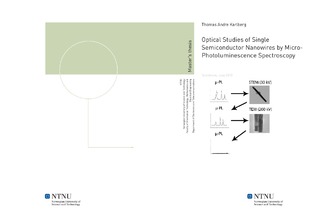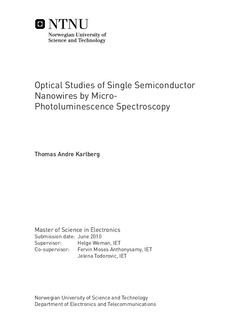| dc.contributor.advisor | Weman, Helge | nb_NO |
| dc.contributor.author | Karlberg, Thomas Andre | nb_NO |
| dc.date.accessioned | 2014-12-19T13:45:58Z | |
| dc.date.accessioned | 2015-12-22T11:44:27Z | |
| dc.date.available | 2014-12-19T13:45:58Z | |
| dc.date.available | 2015-12-22T11:44:27Z | |
| dc.date.created | 2010-10-19 | nb_NO |
| dc.date.issued | 2010 | nb_NO |
| dc.identifier | 357698 | nb_NO |
| dc.identifier.uri | http://hdl.handle.net/11250/2370059 | |
| dc.description.abstract | Over the recent years semiconductor nanowires have gained much attention for their potential to either improve existing technology or create novel devices. This potential has been realized in devices such as semiconductor nanowire lasers[2-3] and nanowire single-photon detectors[4]. With nanowire technology it could be possible to create single-photon nanowire lasers that emit photons in the near infrared region. Such devices should prove very interesting for telecommunications and quantum cryptography.The purpose of this master thesis was the study of the optical properties of GaAs nanowires with GaAsSb inserts. For this reason, both nanowires with and without an AlGaAs coating to increase the nanowire Quantum Efficiency (QE) have been subjected to low temperature PL spectroscopy. In an attempt to determine the physical origin of the different optical properties of different nanowires, µ-PL spectroscopy, Scanning Transmission Electron Microscopy (STEM) and Transmission Electron Microscopy (TEM) was carried out on the same nanowires of a sample with AlGaAs shell nanowires. Through these measurements, it was found that STEM at 30 kV did not change the optical properties of the nanowire, but 200 kV TEM had a detrimental effect on nanowire PL. Through the structurally and optically correlated examination, it was found that stacking faults near the insert was not the origin of the power dependent behavior of the insert emission, and in combination with PL measurements of both zincblende (ZB) and wurtzite (WZ) GaAs nanowires the electronic band structure of the nanowire inserts was determined to very likely be type-II. Also, a theoretical explanation of the origin of the observed insert emission behavior was presented, and polarization dependent PL measurements were presented and discussed. | nb_NO |
| dc.language | eng | nb_NO |
| dc.publisher | Institutt for elektronikk og telekommunikasjon | nb_NO |
| dc.subject | ntnudaim:5369 | no_NO |
| dc.title | Optical Studies of Single Semiconductor Nanowires by Micro-Photoluminescence Spectroscopy | nb_NO |
| dc.type | Master thesis | nb_NO |
| dc.source.pagenumber | 81 | nb_NO |
| dc.contributor.department | Norges teknisk-naturvitenskapelige universitet, Fakultet for informasjonsteknologi, matematikk og elektroteknikk, Institutt for elektronikk og telekommunikasjon | nb_NO |

